
Aristoteles is a lunar impact crater that lies near the southern edge of the Mare Frigoris and to the east of the Montes Alpes mountain range. It was officially named in 1935 after the ancient Greek philosopher Aristotle by the International Astronomical Union, using the classical form of his name.
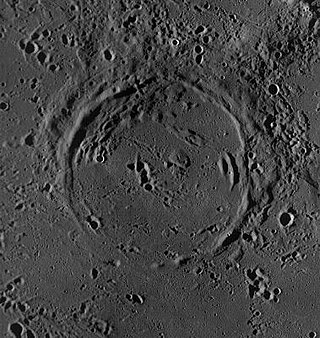
Daguerre is a circular formation near the north end of Mare Nectaris. To the west-northwest is the crater Mädler, and beyond it to the west is the prominent Theophilus. To the north in the rugged continental area between the maria is Isidorus.

Egede is the remains of a lunar impact crater that has been flooded by lava, leaving only the somewhat polygonal circumference of the rim protruding just above the mare. It was named after Dano-Norwegian natural historian Hans Egede. It is located on the southern edge of the Mare Frigoris, to the west of the crater Aristoteles. To the southwest is an arc of low mountains curving between the rims of Aristoteles and Eudoxus. The floor of Egede is flat and nearly featureless, except for a few tiny craterlets, including secondaries from Aristoteles. The surviving rim has a maximum altitude of 0.4 km above the surface.

Galle is a small lunar impact crater on the Mare Frigoris, to the north-northeast of the prominent crater Aristoteles. The formation is nearly circular, with a sharp-edged rim and little appearance of erosion. There are slight outward bulges in the rim to the north and northeast, but otherwise the formation is relatively symmetrical.

Cartan is a small lunar impact crater near the eastern edge of the Moon. It lies just to the west of the larger Apollonius. The rim is circular with a tiny crater along the eastern side. The interior floor is about half the diameter of the crater. A smaller crater attached to the southern rim is also attached to the north rim of Apollonius H, forming a short crater chain.

Eudoxus is a prominent lunar impact crater that lies to the east of the northern tip of the Montes Caucasus range. It is named after the Greek astronomer Eudoxus of Cnidus. It is located to the south of the prominent crater Aristoteles in the northern regions of the visible Moon. To the south is the ruined formation of Alexander, and the small crater Lamèch lies to the southwest.

Baily is the remnant of a lunar impact crater on the boundary between Mare Frigoris to the north and Lacus Mortis to the south. The crater interior has been flooded by lava in the past, and only the northern half of the crater rim remains relatively intact. There is an outward bulge in the northeastern rim, possibly the remnant of another crater formation that once overlapped Baily. The crater interior is flat and relatively featureless, with no impacts of significance. The surviving outer rim reaches a maximum elevation of about 0.5 km.

Bohr is a lunar impact crater that is located near the western lunar limb, in the area that is affected by librations. It is attached to the southwestern rim of the larger, eroded Vasco da Gama formation, and to the southeast of the crater Einstein. The crater was observed for the first time in 1963, by Arthus and Ewen Whitaker in the book Rectified Lunar Atlas.
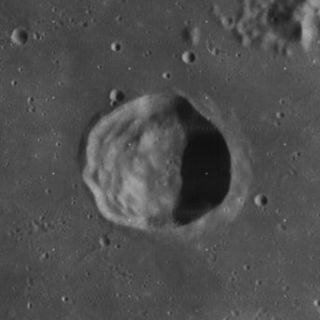
Protagoras is a lunar impact crater that is located on the Mare Frigoris in the northern part of the Moon. To the north-northwest is the slightly larger crater Archytas, and to the southeast is the prominent Aristoteles.

Bellinsgauzen is a lunar impact crater that lies in the southern part of Moon, on the far side from the Earth. It is attached to the northern rim of the larger crater Berlage, and within a half crater diameter of Cabannes to the west. North of Bellinsgauzen is the crater Bhabha.

Belopolʹskiy is a lunar impact crater that is located on the far side of the Moon. It lies to the west of the crater Houzeau, and northeast of Strömgren. Just to the northwest of Belopolʹskiy is the crater Ioffe.

Brouwer is a large lunar impact crater that is located in the southern hemisphere on the far side of the Moon. Intruding into the western rim of Brouwer is the younger and somewhat smaller crater Langmuir. Further to the east-southeast is the larger walled plain Blackett.
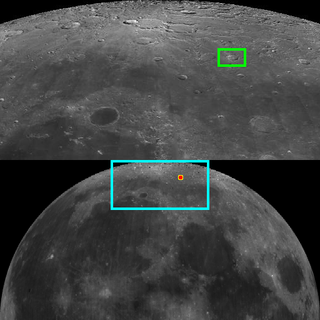
C. Mayer is a lunar impact crater that is located at the northern edge of the Mare Frigoris, due north of the prominent crater Aristoteles. Also to the south, but only a third as distant, is the smaller crater Sheepshanks. Due east of C. Mayer is the flooded crater Kane.

Cook is a lunar impact crater that lies in the western part of the Mare Fecunditatis, just to the southeast of the prominent crater Colombo. To the southwest is Monge.
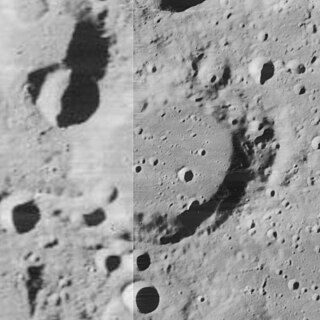
Cleostratus is a lunar impact crater near the northwest limb of the Moon. It lies to the northeast of the crater Xenophanes, and west-southwest of the prominent Pythagoras. From the Earth this crater appears highly elongated due to foreshortening.

Chrétien is a lunar impact crater that is located in the southern hemisphere on the far side of the Moon from the Earth. It lies due south of the Mare Ingenii, one of the few maria on the Moon's far side. The crater lies in the midpoint between the craters Garavito to the west-southwest and Oresme to the east-northeast, both of these being somewhat smaller than Chrétien.

Chevallier is a lunar impact crater that is located in the northeastern part of the Moon's near side, about a crater diameter east-southeast of the prominent crater Atlas. To the south-southeast of Chevallier is the flooded crater Shuckburgh. Chevallier was named by the IAU in 1935.

Coriolis is a lunar impact crater that is located on the far side of the Moon. The crater floor is bisected by the lunar equator, and it lies about three crater diameters northwest of the crater Daedalus.
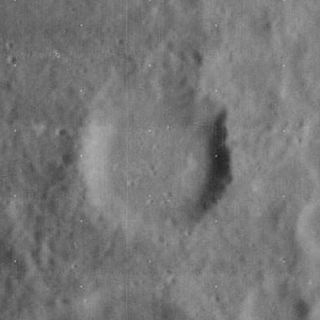
Carrington is a lunar impact crater that is located just to the northeast of the crater Schumacher, in the northeastern part of the near side of the Moon. Carrington was named by the IAU in 1935. It lies in a stretch of rough terrain between two small lunar maria, with Lacus Temporis to the northwest and the smaller Lacus Spei to the east. To the northeast of Carrington is Mercurius.
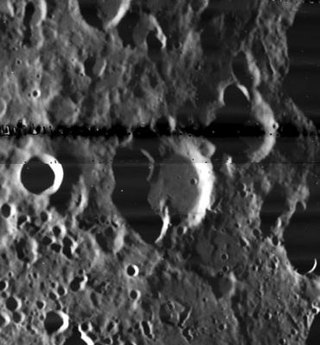
Douglass is a lunar impact crater on the far side of the Moon. It lies to the southwest of the crater Frost and south-southwest of the large walled plain Landau.






















